Experimental Study on Ignition and Pressure-Gain Achievement in Low-Vacuum Conditions for a Pulsed Detonation Combustor
Abstract
:1. Introduction
2. Materials and Methods
2.1. Experimental Design
2.2. Experimental Setup
3. Results and Discussion
3.1. Pressure Data Analysis
3.2. Schlieren Data Analysis
4. Conclusions
5. Future Work
Author Contributions
Funding
Informed Consent Statement
Data Availability Statement
Acknowledgments
Conflicts of Interest
References
- Miele, A.; Wang, T. Optimal trajectories for Earth-to-Mars flight. J. Optim. Theory Appl. 1997, 95, 467–499. [Google Scholar] [CrossRef]
- Bolle, A.; Circi, C.; Corrao, G. Optimal Mars transfers for small payload transportation. Celest. Mech. Dyn. Astron. 2010, 106, 183–196. [Google Scholar] [CrossRef]
- Chen, L.; Li, J. Optimization of Earth-Mars transfer trajectories with launch constraints. Astrophys. Space Sci. 2022, 367, 12. [Google Scholar] [CrossRef]
- Oleson, S.R.; Burke, L.M.; Mason, L.S.; Turnbull, E.R.; McCarty, S.; Colozza, A.J.; Fittje, J.E.; Yim, J.T.; Smith, M.; Packard, T.W.; et al. Compass Final Report: Nuclear Electric Propulsion (NEP)-Chemical Vehicle 1.2. 2021; No. CD-2020-181. Available online: https://ntrs.nasa.gov/citations/20210017131 (accessed on 2 September 2024).
- Burke, L.M.; Oleson, S.R.; Zoloty, Z.C.; Smith, D.; Havens, M. Combined 1-MW Solar Electric and Chemical Propulsion for Crewed Mars Missions. In Proceedings of the ASCEND Conference, Las Vegas, NV, USA, 23–25 October 2023. AIAA 2023-4789. [Google Scholar]
- Cuciumita, C.F.; Cuciuc, T.; Porumbel, I. Evaluation of the Cycle Averaged Performances of a Pulsed Detonation Engine Based on Thermodynamic Cycle Computations. In Proceedings of the ASME Turbo Expo 2016: Turbomachinery Technical Conference and Exposition, Seoul, Republic of Korea, 13–17 June 2016. GT2016-57310. [Google Scholar]
- Innovative Propulsion Cross Cutting Initiative. Available online: https://indico.esa.int/event/441/overview (accessed on 2 September 2024).
- Paschen, F. Über die zum Funkenübergang in Luft, Wasserstoff und Kohlensäure bei verschiedenen Drucken erforderliche Potentialdifferenz. Annalen der Physik 1889, 273, 69–96. [Google Scholar] [CrossRef]
- Loveless, A.M.; Garner, A.L. A universal theory for gas breakdown from microscale to the classical Paschen law. Phys. Plasmas 2017, 24, 113522. [Google Scholar] [CrossRef]
- Liang, X.; Huang, X.; Deng, J.; Jin, S.; Li, L. Spark Ignition Characteristics of Hydrogen Under Ar-O2 Atmosphere. In Proceedings of China SAE Congress 2020: Selected Papers; Springer: Singapore, 2022; pp. 1027–1039. [Google Scholar]
- Kailasanath, K. Review of Propulsion Applications of Detonation Waves. AIAA J. 2000, 38, 1698–1708. [Google Scholar] [CrossRef]
- Wolanski, P. Detonative propulsion. Proc. Combust. Inst. 2013, 34, 125–158. [Google Scholar] [CrossRef]
- Shang, J.; Hu, G.; Wang, Q.; Xiang, G.; Zhao, W. Progress of Experimental Studies on Oblique Detonation Waves Induced by Hyper-Velocity Projectiles. Aerospace 2024, 11, 715. [Google Scholar] [CrossRef]
- Powers, J.M. Oblique detonations: Theory and propulsion applications. In Combustion in High-Speed Flows; Springer: Dordrecht, The Netherlands, 1994; pp. 345–371. [Google Scholar]
- Roy, G.; Frolov, S.; Borisov, A.; Netzer, D. Pulse detonation propulsion: Challenges, current status and future perspective. Prog. Energy Combust. Sci. 2004, 30, 545–672. [Google Scholar] [CrossRef]
- Sorin, R.; Zitoun, R.; Desbordes, D. Optimization of the deflagration to detonation transition: Reduction of length and time of transition. Shock Waves 2006, 15, 137–145. [Google Scholar] [CrossRef]
- Wilson, J.; Wernet, M.P.; Paxson, D.E. Vortex Rings Generated by a Shrouded Hartmann–Sprenger Tube. AIAA J. 2006, 44, 2706–2718. [Google Scholar] [CrossRef]
- Knox, B.; Forliti, D.; Stevens, C.; Hoke, J.; Schauer, F. A comparison of fluidic and physical obstacles for deflagration-to-detonation transition. In Proceedings of the 49th AIAA Aerospace Sciences Meeting Including the New Horizons Forum and Aerospace Exposition, Orlando, FL, USA, 4–7 January 2011; p. 587. [Google Scholar]
- Frolov, S.M.; Smetanyuk, V.A.; Aksenov, V.S.; Koval’, A.S. Deflagration-to-Detonation Transition in Crossedflow Fast Jets of Propellant Components. In Doklady Physical Chemistry; Springer: Berlin/Heidelberg, Germany, 2017; Volume 476, pp. 153–156. [Google Scholar]
- Soni, S.K.; Kaushal, R. Review of the parameters of obstacles affecting deflagration to detonation transition (DDT) for pulse detonation engine application. AIP Conf. Proc. 2021, 2341, 030024. [Google Scholar]
- Zhang, B. Enhancing detonation propulsion with jet in cross-flow: A comprehensive review. Prog. Aerosp. Sci. 2024, 147, 101020. [Google Scholar] [CrossRef]
- Buyakofu, V.; Matsuoka, K.; Matsuyama, K.; Kawasaki, A.; Watanabe, H.; Itouyama, N.; Goto, K.; Ishihara, K.; Noda, T.; Kasahara, J.; et al. Flight demonstration of pulse detonation engine using sounding rocket S-520-31 in space. J. Spacecr. Rocket. 2023, 60, 181–189. [Google Scholar] [CrossRef]
- Goto, K.; Matsuoka, K.; Matsuyama, K.; Kawasaki, A.; Watanabe, H.; Itouyama, N.; Ishihara, K.; Buyakofu, V.; Noda, T.; Kasahara, J.; et al. Space flight demonstration of rotating detonation engine using sounding rocket S-520-31. J. Spacecr. Rocket. 2023, 60, 273–285. [Google Scholar] [CrossRef]
- Cooper, M.; Jackson, S.; Austin, J.; Winterberger, E.; Shepherd, J.E. Direct Experimental Impulse Measurements for Detonations and Deflagrations. J. Propuls. Power 2002, 18, 1033. [Google Scholar] [CrossRef]
- Cooper, M.; Jackson, S.; Shepherd, J.E. Effect of Deflagration-to-Detonation Transition on Pulse Detonation Engine Impulse; GALCIT Report FM00-3; Explosion Dynamics Laboratory, Graduate Aeronautical Laboratories, California Institute of Technology: Pasadena, CA, USA, 2000. [Google Scholar]
- Zhdan, S.A. Structure of Detonation Waves in a Vacuum with Propellant Particles. In Dinamic Aspects of Explosion Phenomena; Progress in Astronautics and Aeronautics; Kuhl, A.L., Leyer, J.-C., Sirignano, W.A., Eds.; AIAA Inc.: New York, NY, USA, 1991; Volume 154, pp. 252–262. [Google Scholar]
- Zhdan, S.A.; Prokhorov, E.S. Initiation of detonation in vacuum suspensions of RDX particles. Combust. Explos. Shock Waves 1998, 34, 426–432. [Google Scholar] [CrossRef]
- Pinaev, A.V. Detonation of Secondary Explosives in a Vacuum Suspension. Combust. Explos. Shock Waves 2001, 37, 214–218. [Google Scholar] [CrossRef]
- Li, X.; Cheng, Y.F.; Zhu, S.J.; Chen, Z.H.; Shen, Z.W. Effects of vacuum degree on the detonation characteristics and energy release laws of RDX explosive. Vacuum 2024, 225, 113270. [Google Scholar] [CrossRef]
- Morris, C.I. Numerical Modeling on Single-Pulse Gas Dynamics and Performance of Pulse Detonation Rocket Engines. J. Propuls. Power 2005, 21, 527–538. [Google Scholar] [CrossRef]
- Yan, Y.; Fan, W.; Wang, K.; Zhu, X.D.; Mu, Y. Experimental investigations on pulse detonation rocket engine with various injectors and nozzles. Acta Astronaut 2011, 69, 39–47. [Google Scholar] [CrossRef]
- Wang, K.; Fan, W.; Lu, W.; Zhang, Q.; Chen, F.; Yan, C.; Xia, Q. Propulsive performance of a pulse detonation rocket engine without the purge process. Energy 2015, 79, 228–234. [Google Scholar] [CrossRef]
- Alam, N.; Sharma, K.K.; Pandey, K.M. Combustion characteristics of hydrogen-air mixture in pulse detonation engines. J. Mech. Sci. Technol. 2019, 33, 2451–2457. [Google Scholar] [CrossRef]
- Cojocea, A.V.; Cuciuc, T.; Porumbel, I.; Gall, M.; Gherman, B.; Crunţeanu, D.E. Experimental Investigations of Hydrogen Fuelled Pulsed Detonation Combustor. In Turbo Expo: Power for Land, Sea, and Air; American Society of Mechanical Engineers: New York, NY, USA, 2022; Volume 86007, p. V03BT04A020. [Google Scholar]
- Vrabie, G.I.; Asoltanei, D.; Cojocea, A.V.; Gall, M.; Cuciuc, T. Experimental Comparison for Different Oxidizers in Hydrogen Fuelled Pulsed Detonation Combustor. TURBO J. 2022, X, 35–49. [Google Scholar]
- Cojocea, A.V.; Porumbel, I.; Gall, M.; Cuciuc, T. Experimental Thrust and Specific Impulse Analysis of Pulsed Detonation Combustor. Appl. Sci. 2024, 14, 5999. [Google Scholar] [CrossRef]
- Bogoi, A.; Cuciuc, T.; Cojocea, A.V.; Gall, M.; Porumbel, I.; Hrițcu, C.E. Experimental Pressure Gain Analysis of Pulsed Detonation Engine. Aerospace 2024, 11, 465. [Google Scholar] [CrossRef]
- Cojocea, A.V.; Porumbel, I.; Gall, M.; Cuciuc, T. Experimental Investigations on the Impact of Hydrogen Injection Apertures in Pulsed Detonation Combustor. Energies 2024, 17, 4918. [Google Scholar] [CrossRef]
- Settles, G.S. Schlieren and Shadowgraph Techniques: Visualizing Phenomena in Transparent Media; Springer Science & Business Media: Berlin/Heidelberg, Germany, 2001. [Google Scholar]


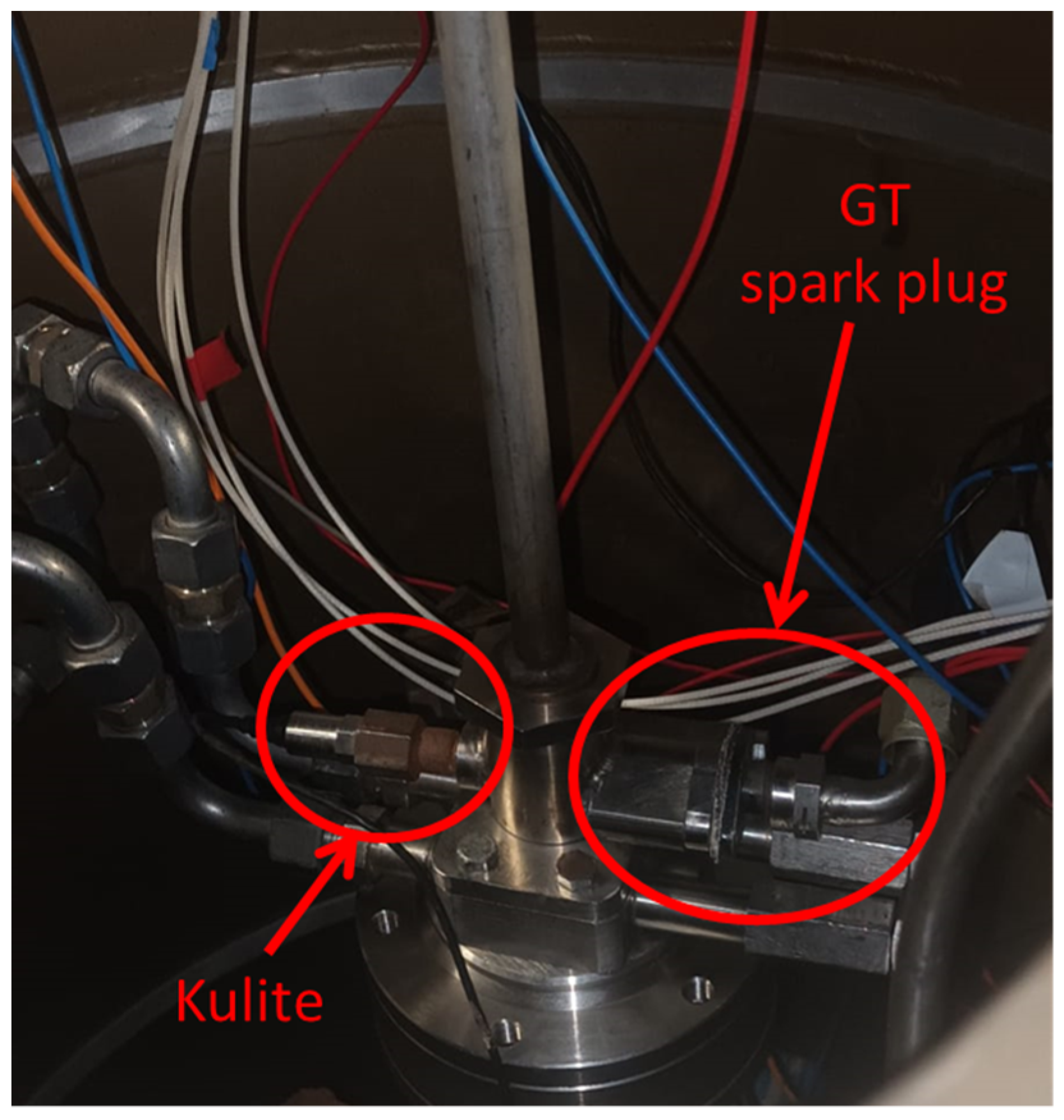

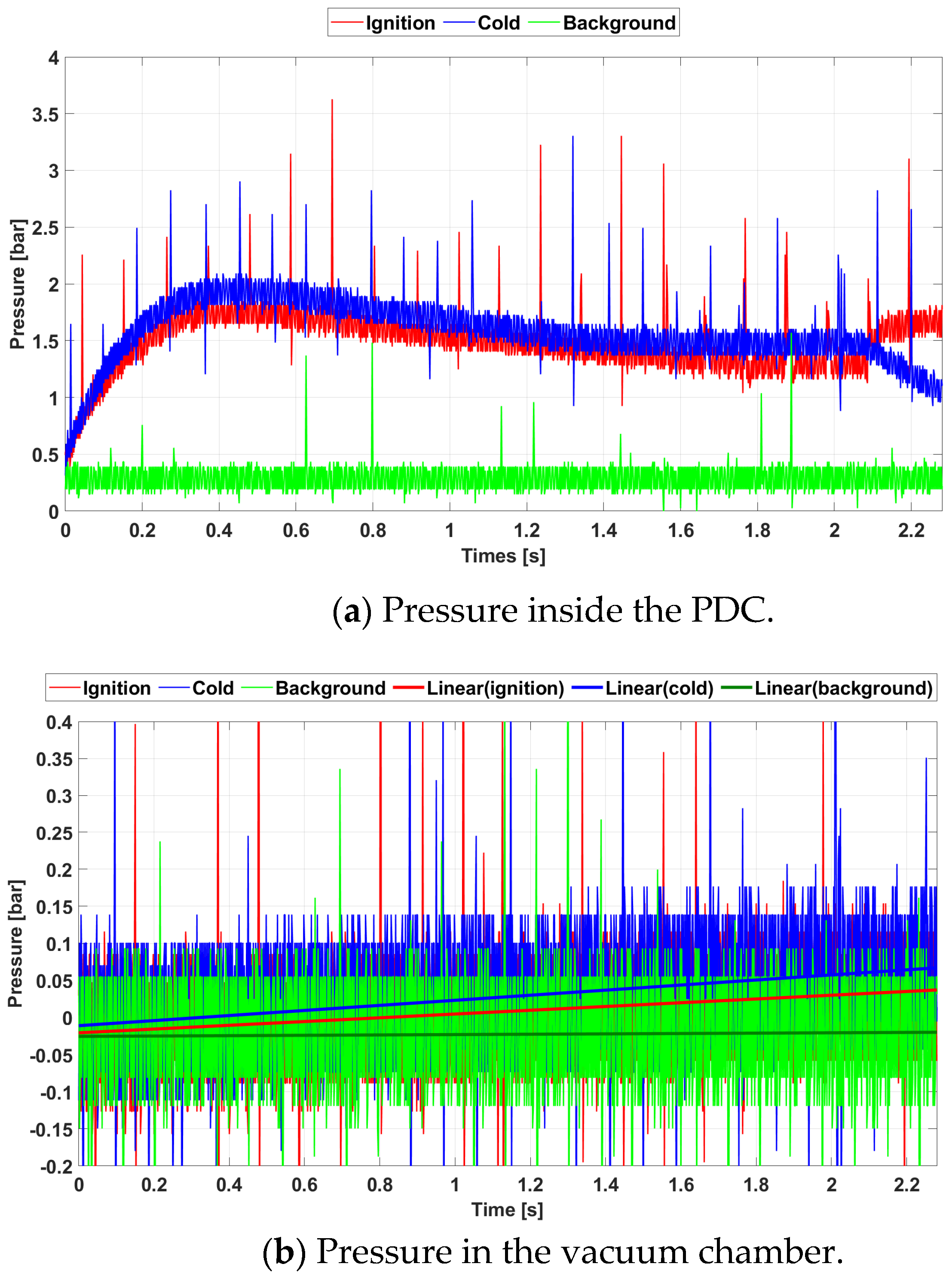
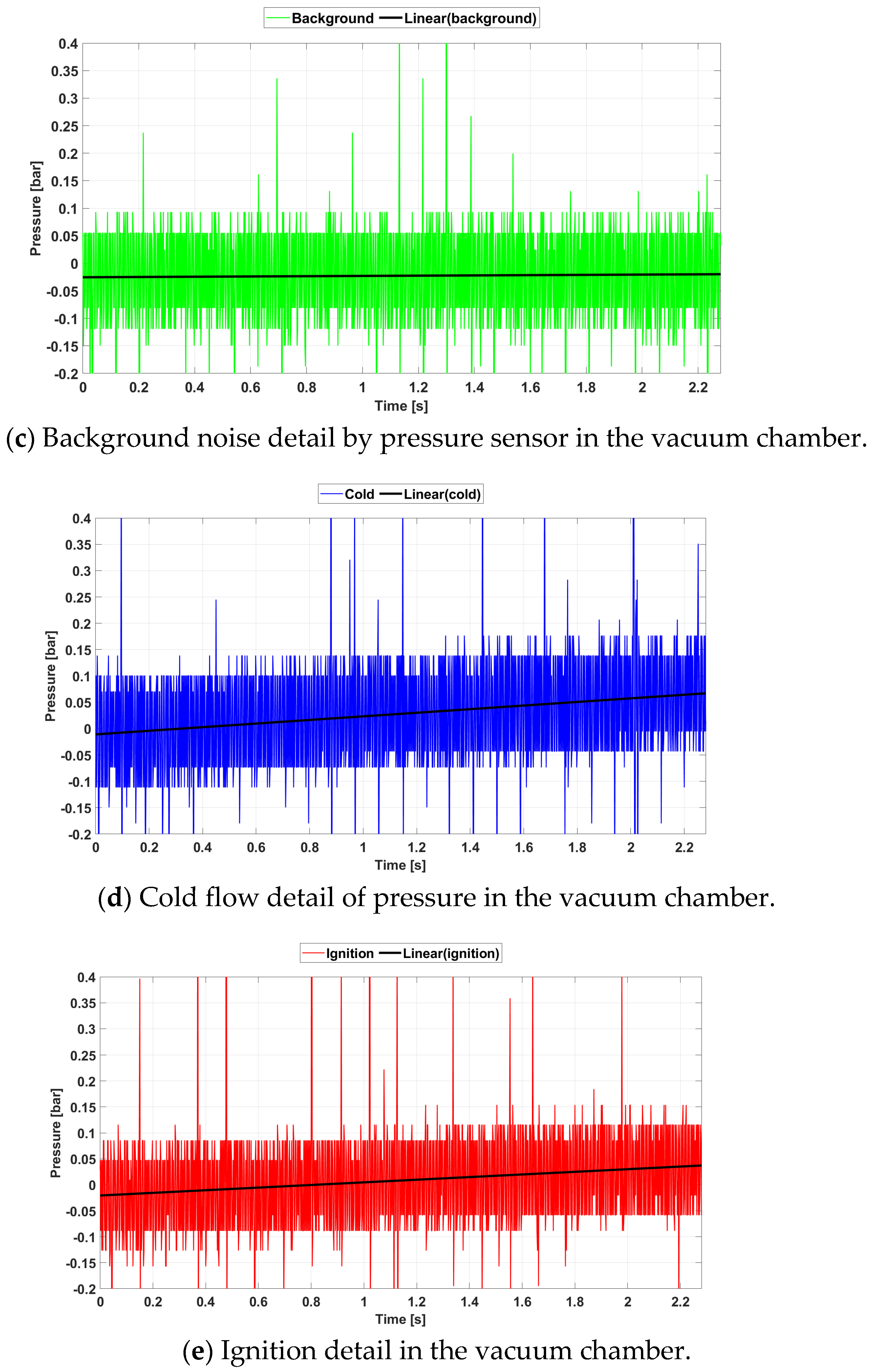
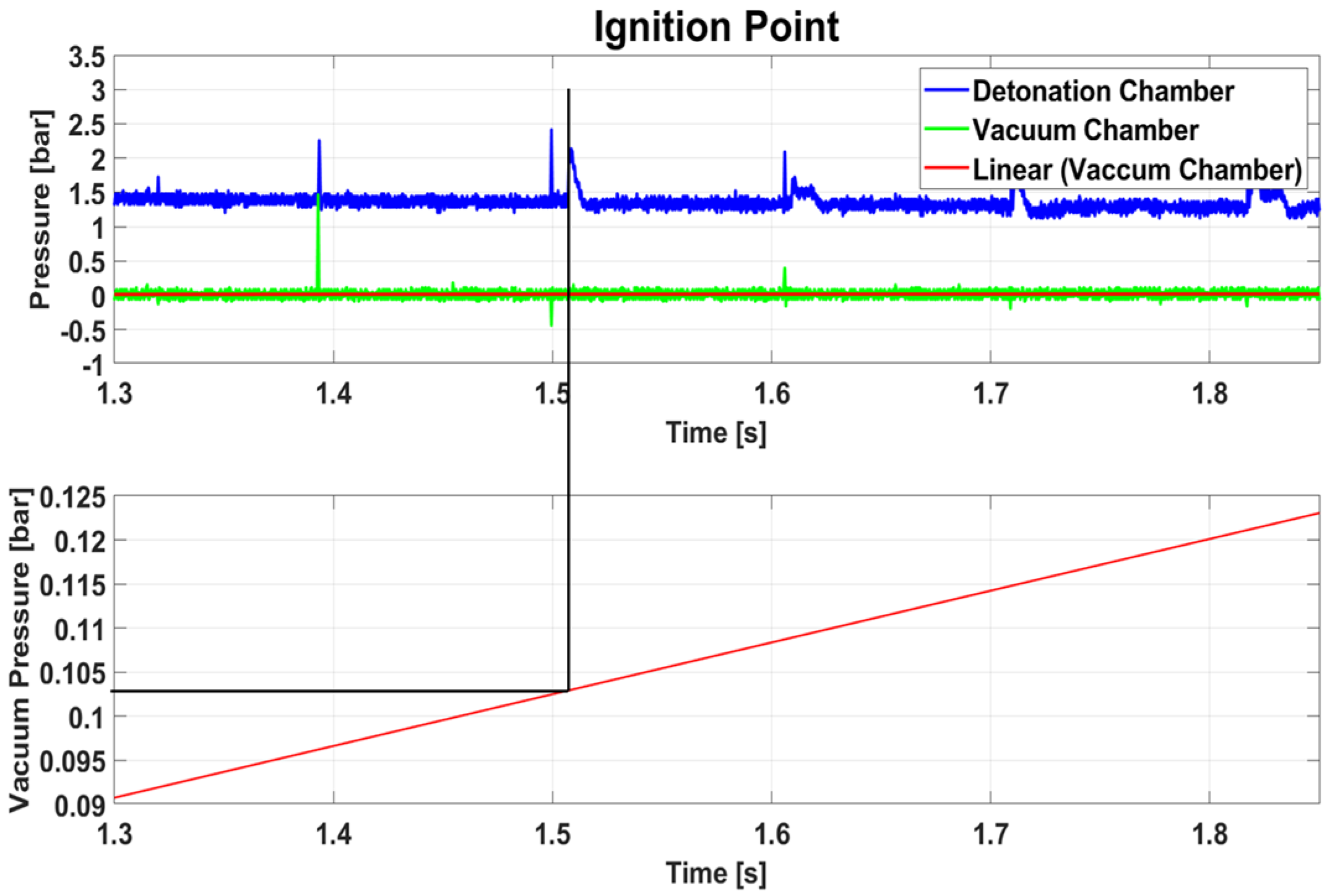




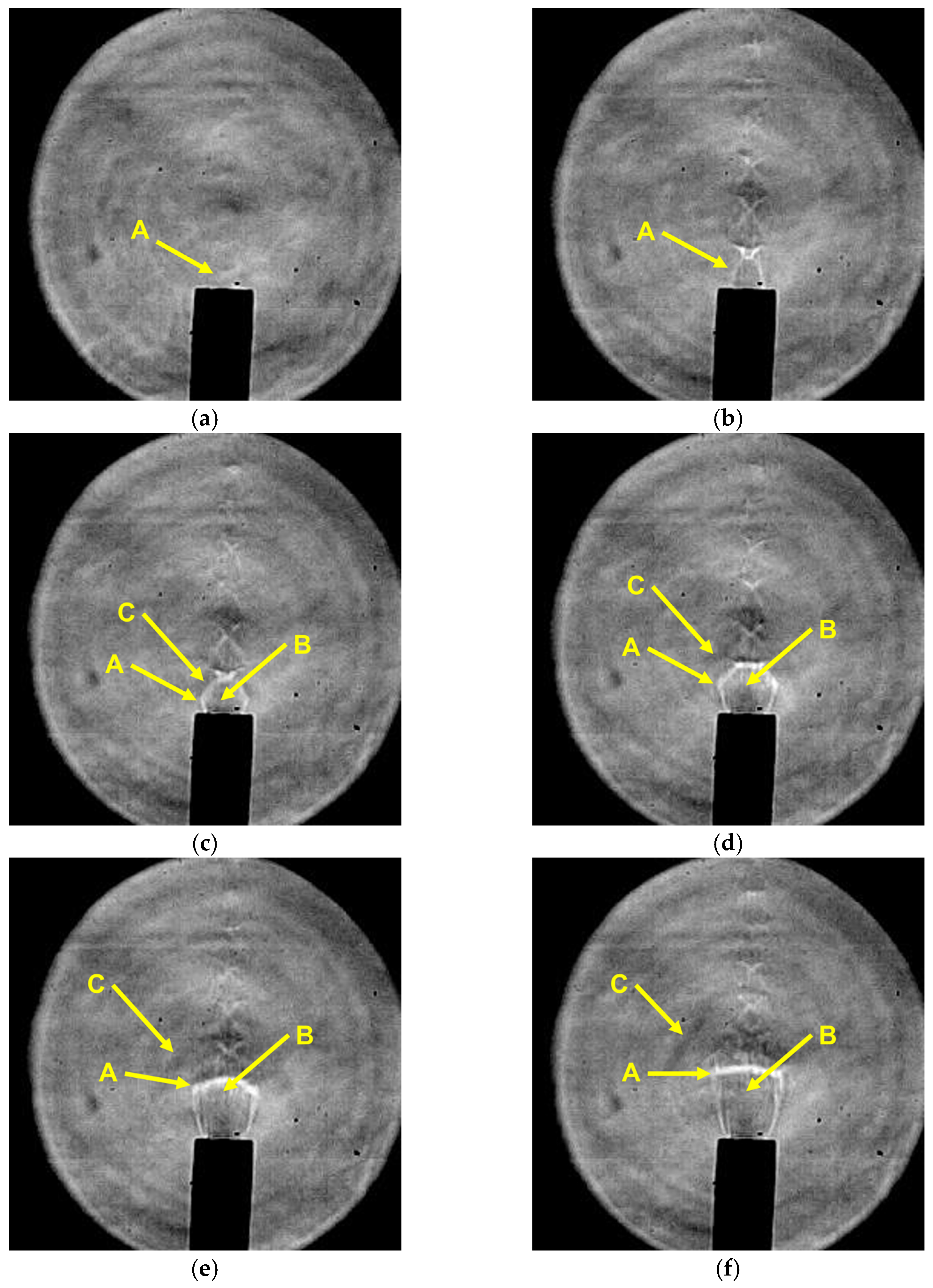

Disclaimer/Publisher’s Note: The statements, opinions and data contained in all publications are solely those of the individual author(s) and contributor(s) and not of MDPI and/or the editor(s). MDPI and/or the editor(s) disclaim responsibility for any injury to people or property resulting from any ideas, methods, instructions or products referred to in the content. |
© 2024 by the authors. Licensee MDPI, Basel, Switzerland. This article is an open access article distributed under the terms and conditions of the Creative Commons Attribution (CC BY) license (https://creativecommons.org/licenses/by/4.0/).
Share and Cite
Cojocea, A.V.; Gall, M.; Vrabie, G.I.; Cuciuc, T.; Porumbel, I.; Ursescu, G.; Crunţeanu, D.E. Experimental Study on Ignition and Pressure-Gain Achievement in Low-Vacuum Conditions for a Pulsed Detonation Combustor. Technologies 2024, 12, 252. https://doi.org/10.3390/technologies12120252
Cojocea AV, Gall M, Vrabie GI, Cuciuc T, Porumbel I, Ursescu G, Crunţeanu DE. Experimental Study on Ignition and Pressure-Gain Achievement in Low-Vacuum Conditions for a Pulsed Detonation Combustor. Technologies. 2024; 12(12):252. https://doi.org/10.3390/technologies12120252
Chicago/Turabian StyleCojocea, Andrei Vlad, Mihnea Gall, George Ionuț Vrabie, Tudor Cuciuc, Ionuț Porumbel, Gabriel Ursescu, and Daniel Eugeniu Crunţeanu. 2024. "Experimental Study on Ignition and Pressure-Gain Achievement in Low-Vacuum Conditions for a Pulsed Detonation Combustor" Technologies 12, no. 12: 252. https://doi.org/10.3390/technologies12120252
APA StyleCojocea, A. V., Gall, M., Vrabie, G. I., Cuciuc, T., Porumbel, I., Ursescu, G., & Crunţeanu, D. E. (2024). Experimental Study on Ignition and Pressure-Gain Achievement in Low-Vacuum Conditions for a Pulsed Detonation Combustor. Technologies, 12(12), 252. https://doi.org/10.3390/technologies12120252








